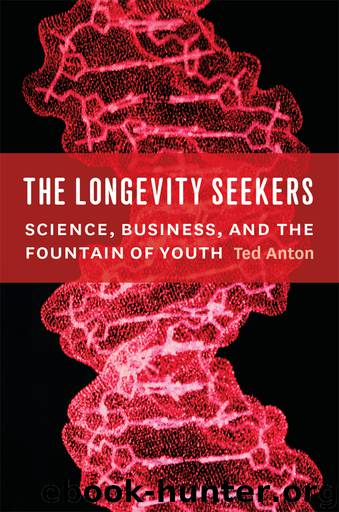The Longevity Seekers: Science, Business, and the Fountain of Youth by Ted Anton

Author:Ted Anton [Anton, Ted]
Language: eng
Format: epub
Publisher: University of Chicago Press
Published: 2013-03-01T16:00:00+00:00
10
Live Long and Prosper: 2009–2010
December fog hugged the Pacific coast as I drove to one of the new labs in the study of longevity genes. Andy Dillin, now Salk Institute investigator and the new director of a Paul Glenn Center for Aging, had uncovered a compound that protects against Alzheimer’s, which led him to join two other researchers and found his own biotech company. “I’m into promoting youth,” he said. On the wall of his medieval-looking office hung a humbling Nietzsche quote his mother sent him: “You moved from worm to man but much within you is still worm.”
By 2010, a new generation of researchers, including Dillin, Coleen Murphy, Heidi Tissenbaum, Anne Brunet, Malene Hansen, and others, competed to understand the ways in which a gene discovery might lead to a treatment of a disease. Is it a coincidence that the rates of Alzheimer’s, cancer, and heart disease all rise with age? No: aging makes us susceptible to illness. The question was whether a longevity gene discovery would yield a treatment. To answer that, they had to change their focus. Rather than asking why we age, which had an almost infinite number of answers, it would be better to ask why we remain healthy as long as we do, which might lead to a few real, working therapies, or at least a promising avenue to explore.
Such applications of basic science required a grueling, boring industrial-type sift through tens of thousands of compounds. A lot of companies were trying, including perhaps Merck, Pfizer, Amgen, GSK, and Novartis, but they were not talking. The people who talked remained the academic researchers, moving from the familiar pure lab to the unfamiliar messy clinic to apply their discoveries. “We’ve become Rapa-land,” the University of Texas’s David Sharp science writer Gary Taubes for Discover magazine, referring to his institution’s complete focus on the compound rapamycin. Such was the new phase of the biology of aging, pushed by investors and government agencies and, most of all, by the public.
Several avenues offered possible applications. Protein shape, cell defenses and repair mechanisms, patterns of healthy gene expression over a lifetime, telomere lengthening, isolating and removing damaged tissues, utilizing the insulin receptor or SIR gene pathway—each was promising in its own way. The challenge was to translate the basic science to patients in the clinic. To do that, one needed to make a high-risk bet on the right mechanism.
Another possibility was almost the opposite: not to improve cell defenses but to reduce them. “Ask any gerontologist to name the top aging diseases, and inflammation will come up in every case,” said Judith Campisi. The defensive mechanisms that protect us early in life may later lead to the rise of cancers and heart disease. Campisi’s and other labs screened for compounds to prevent dying cells from sending out inflammatory signals. Others sought to eradicate those damaged cells altogether. Some studied cancer-free wild animals for clues. Others looked into the mitochondria, the cells’ energy factories.
Most every previous gene discovery remained on the table.
Download
This site does not store any files on its server. We only index and link to content provided by other sites. Please contact the content providers to delete copyright contents if any and email us, we'll remove relevant links or contents immediately.
| Anatomy | Bacteriology |
| Biochemistry | Biostatistics |
| Biotechnology | Cell Biology |
| Embryology | Epidemiology |
| Genetics | Histology |
| Immunology | Microbiology |
| Neuroanatomy | Nosology |
| Pathophysiology | Physiology |
| Virology |
Tuesdays with Morrie by Mitch Albom(4733)
Yoga Anatomy by Kaminoff Leslie(4335)
Science and Development of Muscle Hypertrophy by Brad Schoenfeld(4104)
Bodyweight Strength Training: 12 Weeks to Build Muscle and Burn Fat by Jay Cardiello(3942)
Introduction to Kinesiology by Shirl J. Hoffman(3744)
How Music Works by David Byrne(3235)
Sapiens and Homo Deus by Yuval Noah Harari(3033)
The Plant Paradox by Dr. Steven R. Gundry M.D(2583)
Churchill by Paul Johnson(2544)
Insomniac City by Bill Hayes(2523)
Coroner's Journal by Louis Cataldie(2459)
Hashimoto's Protocol by Izabella Wentz PharmD(2352)
The Chimp Paradox by Peters Dr Steve(2343)
The Universe Inside You by Brian Clegg(2114)
Don't Look Behind You by Lois Duncan(2104)
The Immune System Recovery Plan by Susan Blum(2042)
The Hot Zone by Richard Preston(1996)
Endure by Alex Hutchinson(1993)
Woman: An Intimate Geography by Natalie Angier(1909)
